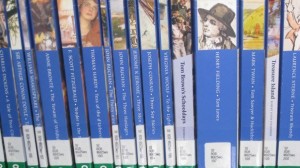While it was similar to most of our public libraries, I thought Namsan had some really nice programs, including a very interesting-sounding one called “Bibliotherapy”.? I love the idea of books as therapeutic and wish I could have understood a little bit more about how it worked, but unfortunately the language barrier was a little more challenging than usual on this visit.?? I did learn that while it is available to anyone, it is most popular with older children and young adults.? A few things I wondered though: How do they choose the books for the program? What makes a book effective as therapy?
I also liked the exchange program that Namsan has organized with Japan.? I hadn’t realized from their website that they actually sent a person there (“human exchange” as Professor Park translated).? Again, I would have liked to know a bit more about that and tried to ask the gentleman who was with us about it when we went by the display but didn’t get too far.? Still, I appreciated the more international aspects of this public library.? (They also had an excellent collection of English-language literature, below).

Just a sample of the impressive English-language collection available at Namsan

Statue outside Namsan Public Library
What struck me most, however, was how busy it was! On a Monday in August, close to 5pm and nearly every seat was taken! That is so interesting because everything I read before coming implied that Koreans didn’t especially value libraries or were just beginning to do so with some concerted efforts by the government. Whether they “value” them or not, they certainly appear to like visiting them!
I also enjoyed the little gallery off the lobby that we visited last.?? At the moment, the exhibit was photography done by a group of either high school or college age students (I couldn’t tell which).? The public library in my home town has a similar room that always displays local art and it’s a very popular feature. What a great way to get the community and local students involved and visiting the library.